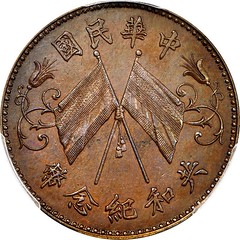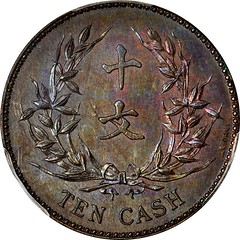
PREV ARTICLE
NEXT ARTICLE
FULL ISSUE
PREV FULL ISSUE
CHINA'S "L. GIORGI" PATTERN TEN CASH COINKyle Ponterio published a Stack's Bowers blog article March 23, 2018 on the L. Giorgi Pattern Ten Cash in the upcoming sale of the Q. David Bowers/R.B. White collection of
Chinese Copper coins. -Editor
  This week’s highlight from the Q. David Bowers/R.B. White collection of Chinese Copper coins is Lot 40299, an incredible pattern 10 Cash, undated (ca. 1914) and signed by the prolific die engraver and head of the Tientsin mint, Luigi Giorgi. As head of the mint from 1910 to 1920 he was tasked with preparing and presenting numerous designs such as the standard Yuan Shih-kai “Fat Man” Dollars and its subsidiaries, including Cash coinage. The obverse features a somewhat familiar design with crossed flags flanked by curled flowers and vines with Chinese inscription above as “????” (Zhonghuá mínguó [Republic of China]) and below “??????” (Gòng hé kou jìniàn bì [Commemorative coin of the Republic]). What differentiates this design from others is that the crossed flags are national flags rather than the national and Kuomintang flags. The reverse features a simplistic design displaying a wreath containing the Chinese inscription “??” (Shí wén [Ten Wen {Cash}]) with the English inscription “Ten Cash” below. It would seem that these short-lived denominations never saw mass production, as even the regular circulation issues are quite scarce. Even though Yuan Shih-kai was disliked by most of the country, the coinage issued under his regime was quite popular, especially the silver issues. They saw mass production and wide circulation up to ten years after his demise on June 4, 1916. Some of the provincial mints up through the warlord period continued producing silver issues. The Anking mint went so far as to debase them to a dismal .560 fine silver. The outstanding work that Giorgi created while in the employ of the Tientsin mint is a testament to his expertise and artistic style. Not only did he create numerous patterns destined for mass production and wide use in early years of the Republic, but he was also responsible for creating the last of the Manchu dragon dollars. To read the complete lot description, see: To read the complete article, see: Wayne Homren, Editor The Numismatic Bibliomania Society is a non-profit organization promoting numismatic literature. See our web site at coinbooks.org. To submit items for publication in The E-Sylum, write to the Editor at this address: whomren@gmail.com To subscribe go to: https://my.binhost.com/lists/listinfo/esylum All Rights Reserved. NBS Home Page Contact the NBS webmaster 
|